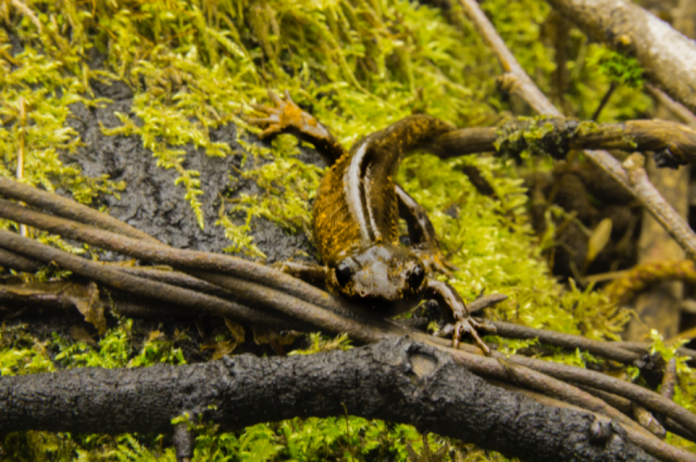Baker pond is six degrees celsius, the ambient air is seven. This means that the northwestern salamander is beginning to become active.
Both UFV Abbotsford D building’s pond and the pond behind Baker House have hosted salamander-related experiments. These salamanders are the reason the pond near D building has been sectioned off for biological research.
The study is UFV lab instructor Christine Dalton’s sabbatical project. She’s been looking at the population size of the aquatic northwestern salamanders who call D building and Baker ponds home. She’s also studying their roaming and breeding habits.
“Salamanders, in general I would say, are under-researched compared to lots of other species,” Dalton said.
Salamanders live in damp, temperate climates, like ours. “We’re kind of in a hot zone for salamanders,” Dalton said. An area like this is an ideal location to carry out these studies.
Last summer, and into the fall, Dalton, with the help of work-study students, trapped aquatic salamanders for a mark and recapture study. Salamanders from D building and Baker ponds were caught and marked with a fluorescent dye, then released home. Some time later, after the trapped population reintegrated into the unmarked population, the team trapped more salamanders and counted how many of those were marked.
Though there is some variation in the exact calculation method used, this essentially reveals how large the population is. The first number of caught salamanders is referenced against the ratio of marked to unmarked salamanders in the second catch.
“We ended up marking 753 animals in a Baker pond, 65 in D building,” Dalton said. “The final calculation will tell us that there’s probably somewhere around 3,000 or 4,000 in Baker pond.”
If only 10 per cent of the second catch salamanders are marked, you’d infer that the amount caught is 10 per cent of the total population.
“It’s a very simple concept, but it’s one of these ecological concepts that people have been working with and fine tuning for a long time.”
Four thousand salamanders is a lot. According to the data, the Northwestern salamander is a species that’s adapting to human influence quite well.
This number is only for the aquatic population of Northwestern salamanders. Northwestern salamanders are neotinic; they can choose to live on land or in water. As they grow and metamorphose, many lose their gills, and move onto land.
Jessica Barclay, UFV student, is hoping to look at the other half of the picture. After the terrestrial salamanders breed, how far do they roam from home?
Barclay is preparing her own research project that will implant radio chips into several terrestrial salamanders. Currently, she’s in the beginning stages of acquiring funding for the chips, and attaining provincial approval.
Monitoring the salamanders with telemetry, she’ll track their movements on land to find out if they live within a square metre or a square kilometre. Currently, there is little literature on the movements of northwestern salamanders.
Implanting chips require minor surgery, and Barclay will learn how to operate on the amphibians from a local vet, then insert the small chips into at least four individuals. The amount depends on the funding secured, and how many chips can be purchased.
Because only a few salamanders will receive chips, the study won’t reveal the lifestyles of all northwestern salamanders, but it will yield a general idea of their home range size.
Home range for animals is where they go geographically, how big of an area they live in. Very few telemetry studies have been performed on northwestern salamanders, so Dalton and Barclay have no idea what they might find.
“Some species’ home range is just two or three metres, others it’s dozens of metres,” Barclay said. “It can be a huge variation.”
“We do know they can only breed in ponds,” Dalton said. “At some point, they’re all either in D pond, or in the Baker House pond.”
But salamanders have been seen on the green between both ponds and near G building, outside Tim Hortons.
“We would like to know if they move between these ponds,” Dalton said. “It’s very exciting to do what [Barclay] is going to do with the terrestrial salamanders, to figure out really where they are on campus. We’ve had so many people tell us they’ve seen salamanders all over.”
As an extension of Dalton’s project, she is also collecting a list of all vertebrate species that live on campus.
“This includes amphibians like the salamanders, but also birds, rabbits, rodents, lizards if there are any,” she said.
As far as amphibians go, Dalton said they’ve previously observed long-tail salamanders, red-legged frog eggs, bullfrogs, pacific chorus frogs, and rough-skinned newts, in addition to the northwestern salamanders.
For information, or to share vertebrate siting, Christine Dalton can be contacted at christine.dalton@ufv.ca.
Image: Joel Robertson-Taylor/The Cascade


